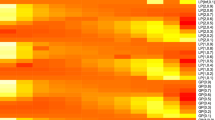Abstract
Single-valued neutrosophic numbers (SVN-numbers) are a special kind of neutrosophic set on the real number set. The concept of a SVN-number is important for quantifying an ill-known quantity and ranking of SVN-number is a very difficult situation in decision-making problems. The main aim of this paper is to present a new ranking methodology of SVN-numbers for solving multi-attribute decision-making problems. Therefore, we firstly define the possibility mean, variance and standard deviation of single-valued neutrosophic numbers. Using the ratio of possibility mean and standard deviation, we have developed the proposed ranking approach and applied to MADM problems. Finally, a numerical example is examined to show the applicability and embodiment of the proposed method.


Similar content being viewed by others
References
Aal SIA, Ellatif MMA, Hassan MM (2018) Two ranking methods of single valued triangular neutrosophic numbers to rank and evaluate information systems quality. Neutrosophic Sets Syst 19:132–141
Atanassov K (1986) Intuitionistic fuzzy sets. Fuzzy Sets Syst 20:87–96
Carlsson C, Fuller R (2001) On possibilistic mean value and variance of fuzzy numbers. Fuzzy Sets Syst 122:315–326
Deli I, Subas Y (2016) A ranking method of single valued neutrosophic numbers and its applications to multi-attribute decision making problems. Int J Mach Learn Cybern. https://doi.org/10.1007/s13042-016-0505-3
Deli I, Şubaş Y (2017) A ranking method of single valued neutrosophic numbers and its applications to multi-attribute decision making problems. Int J Mach Learn Cybern 8:1309–1322
Dubois D, Prade H (1988) Possibility theory: an approach to computerized processing of uncertainty. Plenum, New York
Fuller R, Majlender P (2003) On weighted possibilistic mean and variance of fuzzy numbers. Fuzzy Sets Syst 136:363–374
Garai T, Chakraborty D, Roy TK (2018) A multi-item generalized intuitionistic fuzzy inventory model with inventory level dependent demand using possibility mean, variance and covariance. J Intell Fuzzy Syst 35:1021–1036
Garg H (2017) Novel intuitionistic fuzzy decision making method based on an improved operation laws and its application. Eng Appl Artif Intell 60:164–174
Garg H, Arora R (2018) Bonferroni mean aggregation operators under intuitionistic fuzzy soft set environment and their applications to decision-making. J Oper Res Soc 69:1711–1724
Garg H Nancy (2018) Linguistic single valued neutrosophic prioritized aggregation operators and their applications to multiple attribute group decision making. J Ambient Intell Humaniz Comput :1975–1997
Jiang Q, Jin X, Lee S, Yao S (2019) A new similarity/distance measure between intuitionistic fuzzy sets based on the transformed isosceles triangles and its applications to pattern recognition. Expert Syst Appl 116:439–453
Joshi D, Kumar S (2018) Improved accuracy function for interval-valued intuitionistic fuzzy sets and its application to multi-attributes group decision making. Cybern Syst 49:64–76
Klir JK (1999) On fuzzy set interpretation of possibility. Fuzzy Sets Syst 108:263–273
Li DF, Nan JX, Zhang MJ (2014) A ranking method of triangular intuitionistic fuzzy numbers and application to decision making. Int J Comput Intell Syst 3:522–530
Liu P, Wang Y (2018a) Interval neutrosophic prioritized owa operator and its application to multiple attribute decision making. J Sci Complex 29:681–697
Liu P, Wang Y (2018b) Multiple attribute decision-making method based on single-valued neutrosophic normalized weighted bonferroni mean. Neural Comput Appl 25:2001–2010
Nan JX, Li DF, Zhang MJ (2010) A lexicographic method for matrix games with payoffs of triangular intuitionistic fuzzy numbers. Int J Comput Intell Syst 3:280–289
Pramanik S, Biswas P, Giri BC (2017) Hybrid vector similarity measures and their applications to multi-attribute decision making under neutrosophic environment. Neural Comput Appl 28:1163–1176
Ren S (2017) Multi-criteria decision-making method under a single valued neutrosophic environment. Int J Intell Inf Technol 13:23–37
Smarandache F (1999) A unifying field in logics, neutrosophy: Neutrosophic probability, set and logic. American Research Press, Rehoboth
Sodenkamp MA, Tavana M, Di Caprio D (2018) An aggregation method for solving group multi-criteria decision-making problems with single-valued neutrosophic sets. Appl Soft Comput 71:715–727
Wan PS, Li FD, Rui FZ (2013) Possibility mean, variance and covariance of triangular intuitionistic fuzzy numbers. J Intell Fuzzy Syst 24:847–858
Wang H, Smarandache F, Zhang YQ, Sunderraman R (2010) Single valued neutrosophic sets. Multi-space Multi-struct 4:410–413
Wei G, Wei Y (2018) Some single-valued neutrosophic dombi prioritized weighted aggregation operators in multiple attribute decision making. J Intell Fuzzy Syst 35:2001–2013
Yager RR (1992) On the specificity of a possibility distribution. Fuzzy Sets Syst 50:279–292
Yang XL (2012) Research on the application of MADM in flood risk evaluation, Doctoral dissertation, Huazhong University of Science and Technology
Ye J (2015a) Trapezoidal neutrosophic set and its application to multi attribute decision making. Neural Comput Appl 26:1157–1166
Ye J (2015b) Trapezoidal neutrosophic set and its application to multiple attribute decision-making. Neural Comput Appl 26:1157–1166
Yu D (2016) Softmax function based intuitionistic fuzzy multi-criteria decision making and applications. Oper Res 16:327–348
Zadeh LA (1965) Fuzzy sets. Inf Control 8:338–356
Zadeh AL (1978) Fuzzy sets as a basis for a theory of possibility. Fuzzy Sets Syst 1:3–28
Author information
Authors and Affiliations
Corresponding author
Ethics declarations
Conflict of interest
Authors declare that they have no conflict of interest.
Ethical approval
This article does not contain any studies with animals performed by any of the authors.
Funding
Not applicable
Additional information
Communicated by V. Loia.
Publisher's Note
Springer Nature remains neutral with regard to jurisdictional claims in published maps and institutional affiliations.
Rights and permissions
About this article
Cite this article
Garai, T., Dalapati, S., Garg, H. et al. Possibility mean, variance and standard deviation of single-valued neutrosophic numbers and its applications to multi-attribute decision-making problems. Soft Comput 24, 18795–18809 (2020). https://doi.org/10.1007/s00500-020-05112-2
Published:
Issue Date:
DOI: https://doi.org/10.1007/s00500-020-05112-2




